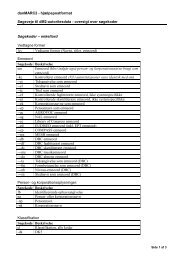RFID Data Model for Libraries - biblstandard
RFID Data Model for Libraries - biblstandard
RFID Data Model for Libraries - biblstandard
Create successful ePaper yourself
Turn your PDF publications into a flip-book with our unique Google optimized e-Paper software.
<strong>RFID</strong> <strong>Data</strong> model <strong>for</strong> libraries Doc 067<br />
Part 2 - Discussion on the data model<br />
- an in<strong>for</strong>mative discussion<br />
2.1 Different approaches to a data model<br />
It has been recognised that a data model <strong>for</strong> library usage of <strong>RFID</strong> tags will have four main<br />
headings: <strong>Data</strong> elements, Values and range, Encoding and Physical mapping. This is<br />
necessary due to the complexity of the technology.<br />
A data model can be constructed according to several principles:<br />
At one end of the spectre there is the ‘One model <strong>for</strong> all purposes’. This model shall be simple<br />
and open <strong>for</strong> any type of usage. This broad variety of usage can be difficult to determine in<br />
advance.<br />
At the other end of the spectre is ‘The open model’ that can vary and be differently introduced<br />
from one library community to another library community. In this case there would be a need<br />
<strong>for</strong> identifiers <strong>for</strong> each version and also a need <strong>for</strong> a registration authority to keep track of<br />
different versions so that a vendor can learn what model to apply <strong>for</strong> what market. This<br />
provides flexibility in the one hand but also bureaucracy on the other.<br />
The aim of the working group is to launch a ‘One model <strong>for</strong> all purposes’, a data model that<br />
can work anywhere without local modifications. The structure of mandatory and optional<br />
parts is an example of this principle.<br />
It can be added that even with this objective no model will last <strong>for</strong> ever. There<strong>for</strong>e a version<br />
identifier will be in the meta data part.<br />
2.2 <strong>Data</strong> elements<br />
This is the core part. Which data elements shall be present and <strong>for</strong> which purpose. <strong>Data</strong><br />
elements can be identified in two dimensions: Content categories and the categories of<br />
mandatory usage or less <strong>for</strong>malised extensions. This can be expressed in a matrix:<br />
13




